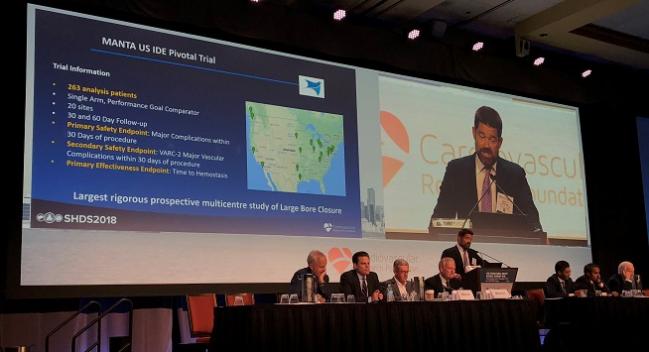SAFE-MANTA: Large-Bore Vascular Closure Device Achieves Fast Hemostasis With Few Complications
One investigator says the data support FDA approval, but whether large-bore vascular closure devices actually get used will also depend on reimbursement.

CHICAGO, IL–Use of a large-bore vascular closure device tested in patients undergoing transcatheter aortic valve replacement and endovascular aortic repair procedures appears to be safe and effective for closing large-bore arteriotomies, according to results of a new, single-arm study.
In 263 patients treated with the Manta (Essential Medical) vascular closure device at 20 North American centers, 5.3% had major complications within 30 days of the procedure.
“With large-bore vascular closure, the idea is for it to be safe, reproducible, effective, and relatively simple, especially when used by different operators with different volumes,” said lead investigator David Wood, MD (University of British Columbia, Vancouver, Canada). “But large-bore closure remains challenging.” In 2018, even though physicians have moved away from surgical closure, percutaneous vascular closure often requires multiple devices and has a failure rate in the range of 5% to 15%, he added.
The Manta vascular device, which combines a bioresorbable collagen plug and suture system to seal the puncture site, is designed to close large bore holes ranging from 10 Fr to 25 Fr at femoral arterial access sites following TAVR, endovascular aneurysm repair (EVAR), balloon aortic valvuloplasty (BAV), or insertion of a ventricular assist device (VAD).
In the SAFE-MANTA study, which was presented here at the 2018 Structural Heart Disease Summit, the majority of patients (84%) were treated with the 18 Fr vascular closure device. The mean target artery diameter was 7.9 mm. Regarding the primary effectiveness endpoint, the mean time to hemostasis was 65 seconds and technical success was achieved in 97.7% of patients. Overall, 227 patients achieved hemostasis in less than 1 minute.
In terms of safety, 14 patients had major complications within 30 days of the procedure. The secondary endpoint of VARC-2 major vascular complications occurred in 11 patients (4.2%). Two patients required surgical repair of the artery and three patients had VARC-2-defined bleeding events. There were eight pseudoaneurysms, including four that did not require treatment (three pseudoaneurysms were treated with compression and one with a thrombin injection).
Although the study included just a single arm, Wood said the results are comparable with the European Manta study that resulted in CE Mark approval in 2016. “We truly believe this is a successful IDE study,” he said.
Hemal Gada, MD (UPMC Pinnacle, Harrisburg, PA), who was not involved in the study, told TCTMD the size of large-bore access sheaths used in TAVR have decreased with second- and third-generation technology, but that vascular closure devices are needed because the puncture sites are still too large to close with manual compression. “You need some sort of closure device,” said Gada. “The failure rate with the current closure systems is high enough to warrant this type of innovation.”
Gada said physicians typically use two Perclose ProGlide (Abbott Vascular) vascular closure devices, which is an internal suture-based system. Once the procedure is completed, the access sheaths are removed, and the sutures are tightened. However, it’s possible for the sutures to tear, or for the hole to be too large to close with the suture, and this can lead to vascular complications, said Gada. In contrast, the Manta vascular closure device works similar to the Angio-Seal (Terumo) vascular closure device, which is an internal, collagen-based plug.
For Gada, the key question going forward is whether the Manta device is cheaper than current closure options. “That’s going to determine whether this is a generally used device or a niche product,” said Gada.
Martin Leon, MD (NewYork-Presbyterian/Columbia University Irving Medical Center, New York, NY), who chaired the session, said it’s difficult to assess the safety and effectiveness of the device in a single-arm study. “It’s hard to know, for instance, in that exact same population, if you used the two-ProGlide technique, how different would the result have been? It’s hard to speculate. Clearly this device is easier to use. You can argue that even if the results were equivalent to two ProGlide [devices], there’s the ease-of-use factor.”
Wood said he believes the single Manta device is a “game-changer” with the potential to become the default closure device given its simplicity, particularly when compared with other large-bore closure systems. To become the standard of care, however, Leon said if approved by the US Food and Drug Administration, cost and reimbursement remain roadblocks before it could be widely adopted in the US.
Michael O’Riordan is the Managing Editor for TCTMD. He completed his undergraduate degrees at Queen’s University in Kingston, ON, and…
Read Full BioSources
Wood D, on behalf of the SAFE Manta study investigators. Pivotal clinical study to evaluate the safety and effectiveness of the Manta percutaneous vascular closure device: the SAFE Manta study. Presented at: Structural Heart Disease Summit 2018. June 22, 2018. Chicago, IL.
Disclosures
- Wood reports no conflicts of interest.


Comments